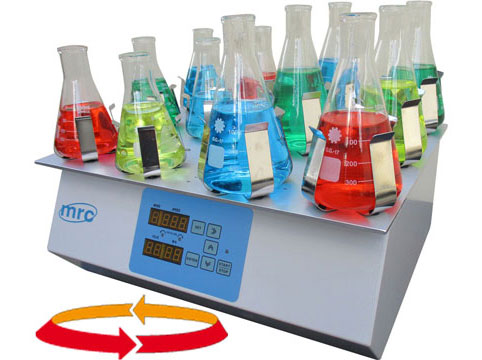Laboratory Shakers are specialized Shakers designed for use in a laboratory setting. These Shakers use low-speed, high-torque motors to provide the necessary power and control to mix sensitive samples. They are typically used to disperse solids into liquids, create emulsions and suspensions, or homogenize cell cultures and tissue samples.
Uses of Laboratory Shaker
A laboratory Shaker aims to homogenize, disperse and mix samples at precise speeds and with precise control. The resulting sample should be uniform in composition and free of clumps, lumps, or other imperfections that can affect the accuracy of test results. Laboratory Shakers are used to mix, emulsify, homogenize, disintegrate, suspend, disperse and dissolve samples safely, controlled, and in a reliable manner.
This mixing action can also help break up sedimented materials and disperse particles evenly in a liquid medium. In addition, some models can perform cell lysis or break down cells for subsequent analysis. Plates agitate violently or in a circular manner to homogenize the sample components.
Some laboratory shakers have tilting plates that shake the solution in multiple directions for an added mixing element. These Shakers come in various sizes, styles, and types to accommodate any laboratory setting: from bench-top models with digital control panels to free-standing units with automated mixing cycles and timers.

Types of Laboratory Shakers
The type of Shaker you select will depend on the specific application, such as mixing cell cultures or creating emulsions. Different Shakers are used for different purposes.
These units are designed for gentle mixing and agitation of samples. These Shakers use two or three rollers that rotate in opposite directions, with each roller providing a different type of motion to ensure uniform results. Rollers keep specimen tubes in a horizontal and immobile position so that you can rotate them on a rotor. They are often used to homogenize fragile samples such as cells, tissues, and proteins. Laboratory rollers are ideal for clinical laboratories, medical research, and biotechnology laboratories.

These shakers are designed to agitate samples in a circular motion, typically at high speeds. These units work best for bacterial cell growth, tissue dissociation, and other applications that don't require a lot of speed.
These Shakers have a digital control panel for fine-tuning the mixing action.
Higher-speed orbital shakers are used for bacterial incubations to keep cells in suspension and provide optimal growth conditions.

Rocker Shakers are designed to shake samples gently from side to side to mix or agitate them. These units are ideal for mixing cell cultures and tissue homogenization in blotting applications. Rocker Shakers usually accommodate two to four microtiter plates or various sizes of Erlenmeyer flasks with a shaking speed ranging from 10 to 300 RPM.
Things to Considerations Before Purchasing a Laboratory Shaker
When purchasing a laboratory Shaker, there are several factors to consider. To start, you must establish the performance metrics that your lab requires. This includes the speed range, capacity, and type of material that needs to be mixed. Here are a few things to keep in mind:
- ●If you want to purchase temperature-sensitive samples, here are a few things to remember. Specific Shakers provide temperature control and heated mixing options for sensitive samples. A stirrer with hot plates is perfect for temperature control while mixing samples.
- ●The right-sized stirrer or Shaker is important because volumes can differ from sample to sample. Make sure the Shaker you select can accommodate a wide range of volumes to remain versatile and reliable. It is essential for overhead stirrers that the rotor speed and agitator shaft sizes are tough enough to blend the highest and lowest requirement volumes. You should make sure you purchase a large enough plate-size Shaker to accommodate the maximum volume of your sample requirement for magnetic stirrers or vortexes.
- ●New magnetic and overhead stirring systems are cutting-edge, designed to save you time by carrying out specific stirring patterns while taking care of agitation-sensitive samples. Depending on the needs of your laboratory, you may want to consider a Shaker that comes with digital controls or automated mixing cycles.
By considering factors like performance specifications, temperature control, volume size, and capacity, you can purchase the right mixture for your lab's needs. With the right equipment, you'll have an efficient and reliable way of mixing samples every time.
Conclusion
These are some of the most important things to keep in mind when selecting a laboratory Shaker for your lab. With the right type and model, you can ensure accuracy and repeatability in any application. The key is to select a Shaker that meets all of your laboratory requirements to perform optimally every time it is used. Doing so will help you increase efficiency, productivity, and accuracy in any laboratory setting.